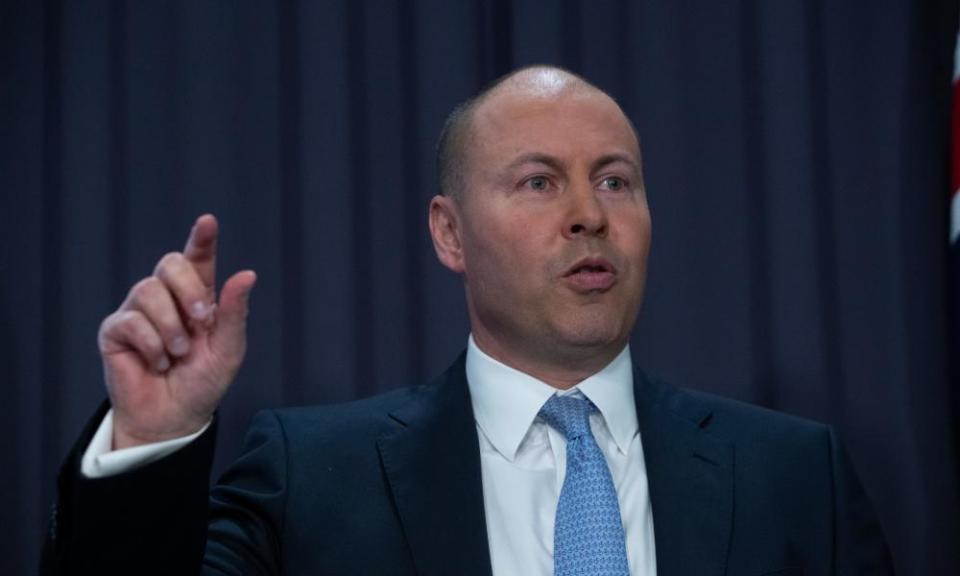All the recent growth can't hide the fact that Australia remains in a deep recession

Despite what the Treasurer would have you believe, Australia is not out of a recession, and while the September quarter GDP figures were good, mostly they were good because the June quarter was so bad.
Before I go any further, let’s just point out how important it is to keep Covid-19 under control. The latest growth figures confirm just how vital preventing a pandemic is to keeping your economy (and society in general) going:
Graph not appearing? View here
The latest national accounts showed that the economy grew a pretty stunning and yet not exceedingly surprising 3.3% in the September quarter.
If we were in normal times you would almost suspect we’re about to pave the streets with gold and swim in pools filled with money.
But no, we are not in normal times.
The treasurer, Josh Frydenburg, in a rather Trumpian way, tried to spin the news as good because the September quarter was the strongest growth since March 1976. That 1976 quarter also came off the back of two quarters of negative growth (falls of 1.1% and 1.5%).
This time the massive growth came after the biggest one quarter fall ever (7%):
Graph not appearing? View here
So horrific was the June quarter fall that the economy is still 3.8% below what it was a year ago, and our GDP per capita is 4.8% lower than it was this time last year.
That, my friends, is an economy still in a recession.
Just to reinforce where we are at, in the 241 quarters since September 1960, only 15 times has our GDP fallen so badly that it was smaller than it was a year earlier. The worst fall occurred in the June quarter this year, and the second worst in the September quarter:
Graph not appearing? View here
Our economy shrunk nearly three times more in the past year than it did at the worst point of the 1990s recession.
That is a recession.
The people who think a recession only means two consecutive quarters of negative growth are people you really should avoid paying any attention to.
If we look at labour underutilisation, the increase since the low point of the past year is still worse than occurred during the GFC or the 1990s recession:
Graph not appearing? View here
In October there were 462,000 more people underemployed or unemployed than there was in March.
That is a recession.
But let us not be too gloomy. The figures were better than predicted.
Because our fall in June was not as bad as most in the OECD, neither was the jump in September as big. Overall our annual growth puts us around average of the OECD, and that’s perfectly fine:
Graph not appearing? View here
The growth in September was driven largely by the easing of restrictions.
And with the easing, we went shopping – household consumption jumped 7.9% (a record by 4.6%pts). But because it fell 12.5% (a record by 10.5%pts) overall household consumption was still down 6.5% on last year.
It highlights just how early it is to start reading anything into the figures:
Graph not appearing? View here
In the September quarter household spending added 4.0%pts to GDP growth – far and away the biggest contributor:
Graph not appearing? View here
That increase is also why imports detracted from growth – we bought a lot of stuff from overseas that we hadn’t been able to do during the lockdowns.
Public investment did help boost GDP a bit in this quarter, but mostly that was defence spending.
National defence investment grew 10.6% in the quarter while national government non-defence investment fell 4.7%.
Overall the private domestic economy is in a very deep hole – down 6.5% on where it was last year. That is much better than the 12.3% fall in June, but still well below anything experienced in recent times:
Graph not appearing? View here
Frydenberg might have told reporters on Wednesday that “government is not the solution” but government spending sure as heck is what is keeping things going for many households.
In the past year social assistance benefits grew by 48% while wages and salaries increased just 1.4%:
Graph not appearing? View here
It has caused real household disposable income per capita to jump quite appreciably this year – up 7.5% since December. If we excluded social assistance benefits, the jump would be a much less (but still impressive given the recession) 2.9%:
Graph not appearing? View here
Combined with other spending, public sector demand grew 6.1% in the past year and it means the contribution of government spending to annual GDOP growth is almost double that of the GFC stimulus cheques.
But thus far there has been little public investment to speak of:
Graph not appearing? View here
The good news is the growth is better than expected and put us nicely ahead of the path back to square within five years:
Graph not appearing? View here
In June the economy did not just fall 7%, it also was 8.4% below where we would have expected things to be had we followed the medium-term trend. After the strong growth in September we are now 6% behind that trend.
That 6% loss of expected output is the real sign of how big of a hole we are in. In September Australia’s economy was effectively the size it was three years ago.
And all the nice one quarter growth and talk of technicalities cannot hide the fact that when you have fallen back three years, your economy remains in a very deep recession.

 Yahoo Finance
Yahoo Finance 